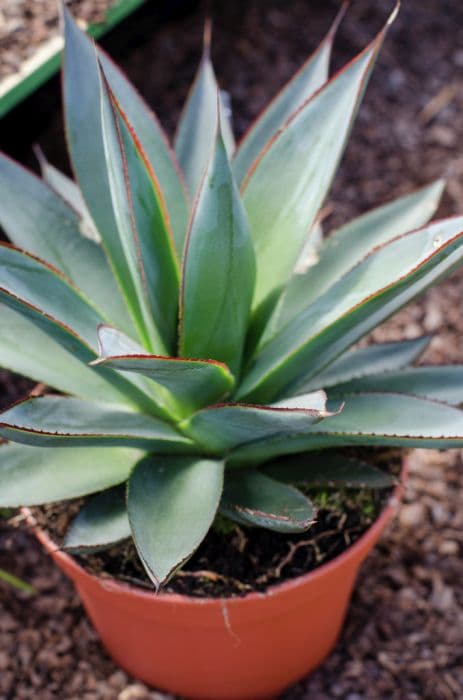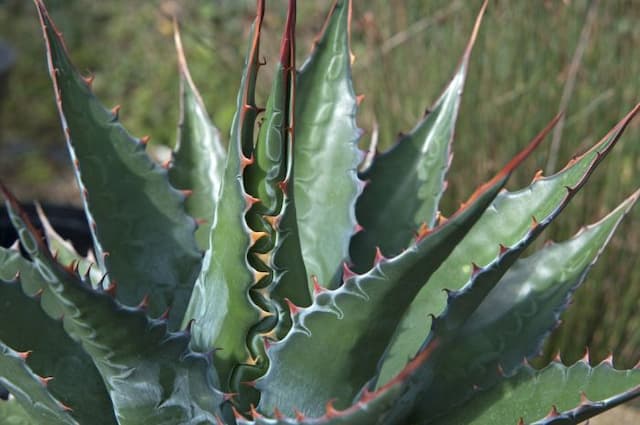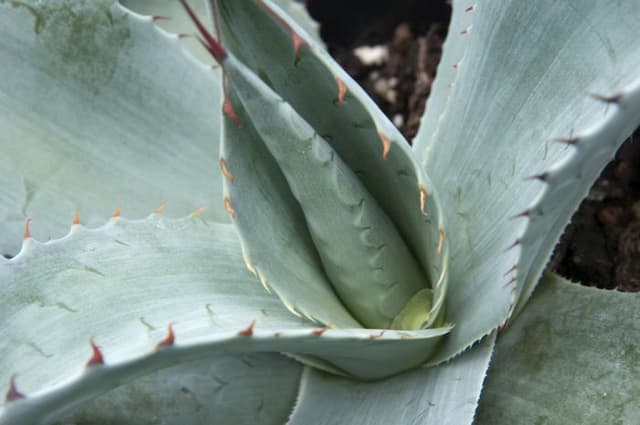Dutch Hyacinth Hyacinthus orientalis 'Royal Navy' (d)

ABOUT
The Hyacinth 'Royal Navy' is a strikingly beautiful plant known for its rich, deep blue flowers. Resembling a dense spike or column, the blooms are tightly packed with small, star-shaped flowers that cascade around the central stem. Each individual flower contributes to the overall cone-like shape of the flower head, creating a plush and luxurious appearance. The petals have a slightly wavy or curly edge, adding to the fullness of the blossom and giving it a textured look. The color of the 'Royal Navy' is particularly noteworthy—a deep, vibrant blue that sometimes appears almost navy in intensity, which is quite rare and highly sought after in the floral world. When in full bloom, the contrast between the blue flowers and the dark green, glossy, strap-like leaves is especially eye-catching. The leaves grow upright and provide a simple yet elegant backdrop to the showy spikes of flowers, highlighting their magnificence. Furthermore, the flowers emit a strong, sweet, and pleasant fragrance which can fill the surrounding area and attract passersby or wildlife like bees. The overall impression of the Hyacinth 'Royal Navy' is one of opulence and splendor, making it a beloved choice for gardeners who wish to add a splash of luxurious color and irresistible aroma to their early spring gardens.
About this plant
 Names
NamesFamily
Asparagaceae
Synonyms
Common Hyacinth, Dutch Hyacinth, Garden Hyacinth, Oriental Hyacinth
Common names
Hyacinthus orientalis 'Royal Navy' (d).
 Toxicity
ToxicityTo humans
The most common common name of the plant Hyacinthus orientalis 'Royal Navy' is hyacinth. Hyacinth bulbs contain alkaloids that can be toxic if ingested, leading to symptoms like nausea, vomiting, diarrhea, and sometimes could cause difficulty in breathing or an increased heart rate if a large amount is consumed. Handling hyacinth bulbs can also cause skin irritation or allergic reactions in some individuals.
To pets
Hyacinth, the common name for Hyacinthus orientalis 'Royal Navy', is toxic to both cats and dogs. If a pet ingests any part of the plant, especially the bulbs, it can lead to symptoms such as vomiting, diarrhea, depression, tremors, and increased drooling. In severe cases, ingestion can result in an increase in heart rate and changes in respiration. If suspected poisoning occurs, it is crucial to seek veterinary care.
 Characteristics
CharacteristicsLife cycle
Perennials
Foliage type
Deciduous
Color of leaves
Green
Flower color
Blue
Height
6-12 inches (15-30 cm)
Spread
4-6 inches (10-15 cm)
Plant type
Bulb
Hardiness zones
4
Native area
Mediterranean
Benefits
 General Benefits
General Benefits- Decorative Appeal: Hyacinth 'Royal Navy' boasts deep blue flowers that add striking color to gardens and container plantings.
- Fragrance: The plant is well-known for its strong, pleasant fragrance that can perfume a garden or indoor space.
- Spring Blooming: As a spring-blooming bulb, it provides early seasonal color after a long winter.
- Attracts Pollinators: Hyacinths, including the 'Royal Navy' variety, attract bees and other pollinators, supporting local ecosystems.
- Easy to Grow: This plant is relatively easy to cultivate in a variety of soil types and garden conditions.
- Forced Blooming: Suitable for 'forcing' indoors, which allows gardeners to enjoy their beautiful flowers and scent during the winter.
 Medical Properties
Medical PropertiesThis plant is not used for medical purposes.
 Air-purifying Qualities
Air-purifying QualitiesThis plant is not specifically known for air purifying qualities.
 Other Uses
Other Uses- Biodegradable dye: The deep blue petals of the Hyacinth can be crushed and used as a natural fabric dye, providing an eco-friendly alternative to synthetic dyes.
- Educational tool: Hyacinths can be used in school projects to teach students about plant biology, bulb growth, and the lifecycle of plants.
- Art supplies: The vibrant petals can be pressed and used in artistic creations, such as botanical prints or in the production of handmade paper.
- Aromatherapy: The strong fragrance of the Hyacinth can be used in homemade potpourri to provide a natural and soothing scent to living spaces.
- Scented stationery: Rubbing the petals on paper can infuse personal letters or note cards with a delicate fragrance, adding a personal touch to correspondence.
- Perfume: The essence of the flowers can be extracted and used as a natural component in homemade perfumes or scented oils.
- Crafting eco-friendly candles: The scent of Hyacinth can be infused in beeswax to create aromatic, natural candles.
- Garden mulch: After blooming, the foliage and spent blooms can be composted and used as a nutrient-rich mulch for gardens.
- Color indicator in pH experiments: The petals may be used in educational settings to create a natural pH indicator, which changes colors in the presence of acids or bases.
- Petal art: Children and adults alike can use the colorful petals for creating intricate mosaics or decorative collages on various surfaces.
Interesting Facts
 Feng Shui
Feng ShuiThe Hyacinth is not used in Feng Shui practice.
 Zodiac Sign Compitability
Zodiac Sign CompitabilityThe Hyacinth is not used in astrology practice.
 Plant Symbolism
Plant Symbolism- Consistency - Hyacinths, due to their perennial nature, symbolize steadiness and reliability in life.
- Playfulness - The vibrant colors and delicate shapes of hyacinth flowers can represent playfulness and a sporty attitude towards life.
- Beauty - The striking beauty of Hyacinth flowers has long been admired, leading them to symbolize beauty and loveliness.
- Rebirth - As a flower that blooms in the spring, hyacinths represent rebirth and the renewal that comes with this season.
- Sorrow - In the language of flowers, hyacinths can also represent sorrow and the desire for forgiveness, possibly stemming from the Greek myth of Hyacinthus.
- Jealousy - The hyacinth can sometimes symbolize jealousy, which also echoes back to its Greek mythological origins where Zephyr's jealousy led to Hyacinthus’s death.
 Water
WaterFor the Hyacinth 'Royal Navy', water thoroughly when the top inch of soil feels dry, which is typically once every 5-7 days depending on environmental conditions. Provide enough water to moisten the soil all the way through, but avoid waterlogging as this can lead to bulb rot. During active growth, in spring, you may need to water more frequently, while after blooming, reduce watering as the foliage begins to die back. In terms of the amount, use approximately half a gallon of water per plant during each watering session, making sure the water penetrates the soil evenly around the bulb. Adjust the amount based on the size of the pot or garden area, to ensure adequate moisture reaches the roots.
 Light
LightThe Hyacinth 'Royal Navy' thrives in full sun to partial shade. The ideal spot would be where the plant receives at least six hours of direct sunlight daily. If planted indoors, a south-facing window is generally the best location, while outdoors, an area that gets morning sun and afternoon shade can also be beneficial to protect the blooms from intense afternoon heat.
 Temperature
TemperatureHyacinth 'Royal Navy' prefers moderate temperatures ranging from 60 to 70 degrees Fahrenheit. The plants can tolerate temperatures as low as the upper 20s for brief periods, but sustained cold can damage the foliage and flowers. The ideal growing condition is when daytime temperatures are mild and there's a notable difference in night temperatures, as cooler nights help prolong bloom time.
 Pruning
PruningThe Hyacinth 'Royal Navy' requires minimal pruning, mainly deadheading spent flowers to promote bulb vigor for the following year instead of seed development. Once the flowers fade, cut the flower stalks near the base of the plant, but leave the foliage in place until it turns yellow and dies back naturally, usually by early summer. This allows the leaves to photosynthesize and store energy in the bulb for next year's growth.
 Cleaning
CleaningAs needed
 Soil
SoilThe best soil mix for a Hyacinth (Hyacinthus orientalis 'Royal Navy') should be well-draining with a mix of loam, sand, and compost. The soil pH should be mildly acidic to neutral, ideally between 6.5 and 7.0.
 Repotting
RepottingHyacinths (Hyacinthus orientalis 'Royal Navy') generally do not need frequent repotting and should be repotted every 2-3 years to refresh the soil.
 Humidity & Misting
Humidity & MistingHyacinths (Hyacinthus orientalis 'Royal Navy') prefer average household humidity levels. No special humidity conditions are required.
 Suitable locations
Suitable locationsIndoor
Provide bright light, cool temps, and avoid overwatering.
Outdoor
Plant bulbs in fall, well-draining soil, full sun to part shade.
Hardiness zone
4-8 USDA
 Life cycle
Life cycleThe common hyacinth, including Hyacinthus orientalis 'Royal Navy', begins its life cycle with a dormant bulb which breaks dormancy in the fall or early winter. The bulb roots actively before sending up a shoot as temperatures start warming in early spring. The shoot grows into a stem that bears dense clusters of fragrant, deep blue flowers. After blooming, which occurs in mid-spring, the plant enters a period of photosynthesis and energy storage as the leaves remain green and photosynthetically active. Once the leaves yellow and wither, the plant returns to dormancy in the summer, conserving energy within the bulb. The cycle repeats when the weather cools, and the plant prepares for another active growing season.
 Propogation
PropogationPropogation time
Spring
The most popular method of propagating the common garden hyacinth, particularly the Hyacinthus orientalis 'Royal Navy', is through the division of its bulbs, typically undertaken in late summer or early fall, after the foliage has died down. Gardeners separate offsets, also known as "bulblets", from the mature bulbs; these are small bulbs that form at the base of the parent bulb. The offsets should be carefully snapped or cut off – ensuring that each segment has a portion of the base plate for root development. Once removed, they are left to dry for a day or two to allow the wound to callus and reduce the risk of rot. The separated bulblets are then planted about 4 inches (10 centimeters) deep and at least 3 inches (approximately 8 centimeters) apart in well-drained soil and a sunny location where they can develop and reach flowering size in a few years.









